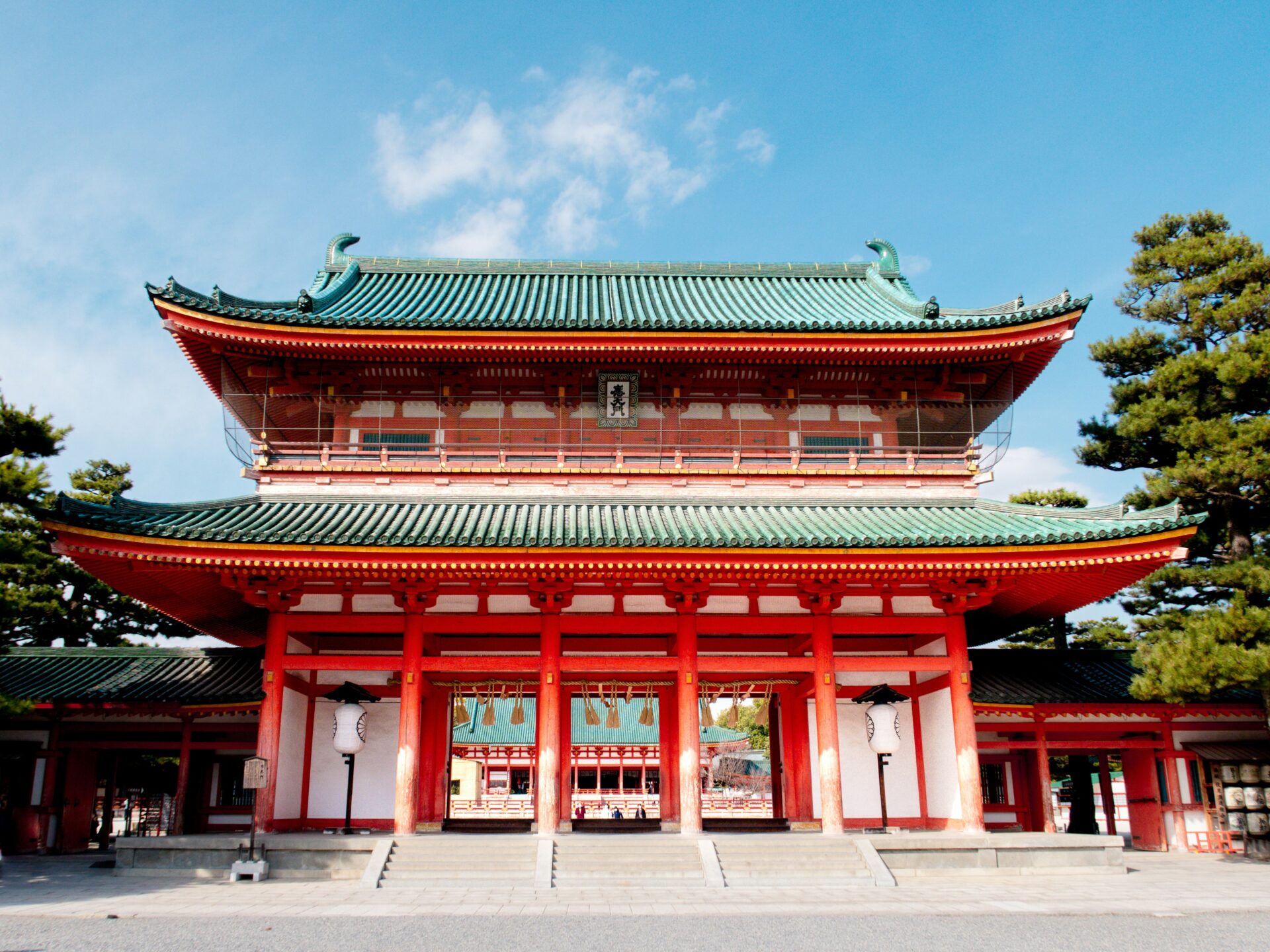Intrigued by Japan’s rich history but unsure where to begin your exploration? You’ve likely heard whispers of Kyoto’s iconic Heian Jingu Shrine and wondered about its global acclaim. Many travelers share your curiosity, yet the sheer volume of Kyoto’s cultural offerings can feel overwhelming.
This guide is designed for the culturally curious traveler seeking both insight and inspiration. We’ll delve into Heian Jingu’s captivating history, admire its stunning architectural marvels, and explore its seasonal beauty. We’ll also provide practical tips to ensure a seamless and memorable visit.
By the end, you’ll be well-equipped to fully experience the shrine’s magic – from capturing the ethereal beauty of cherry blossoms in spring to marveling at the grandeur of its torii gate against the backdrop of a winter sky. Let this guide be your starting point for an unforgettable Kyoto adventure.
Introduction: Why Visit Heian Jingu?

Heian Jingu: A Historical and Cultural Gem
Heian Jingu, located in Kyoto, is a magnificent Shinto Jingu built in 1895. It was established to commemorate the 1,100th anniversary of Kyoto’s founding as Japan’s capital. Dedicated to Emperor Kanmu and Emperor Komei, it symbolizes Kyoto’s rich cultural heritage.
The Jingu is renowned for its grand torii gate and beautiful architecture inspired by the ancient Heian period. Visitors can also explore its lush gardens, which showcase traditional Japanese landscaping. Heian Jingu is not just a historic site; it’s a cultural treasure that offers a glimpse into Japan’s glorious past.
Discover the Beauty of Heian Jingu: A Kyoto Icon
Among Kyoto’s countless historic sites, Heian Jingu stands out for its unique blend of history, culture, and beauty. Its massive torii gate and vibrant red structures provide the perfect backdrop for stunning photos.
The spacious Jingu grounds and tranquil gardens offer a peaceful escape from the city’s bustle. Seasonal highlights, like cherry blossoms in spring and vibrant autumn foliage, make it a must-visit year-round. Whether you’re a history enthusiast or a nature lover, Heian Jingu offers an unforgettable experience that encapsulates the essence of Kyoto.
A Glimpse into History: The Birth of Heian Jingu
Background of the Establishment of Heian Jingu
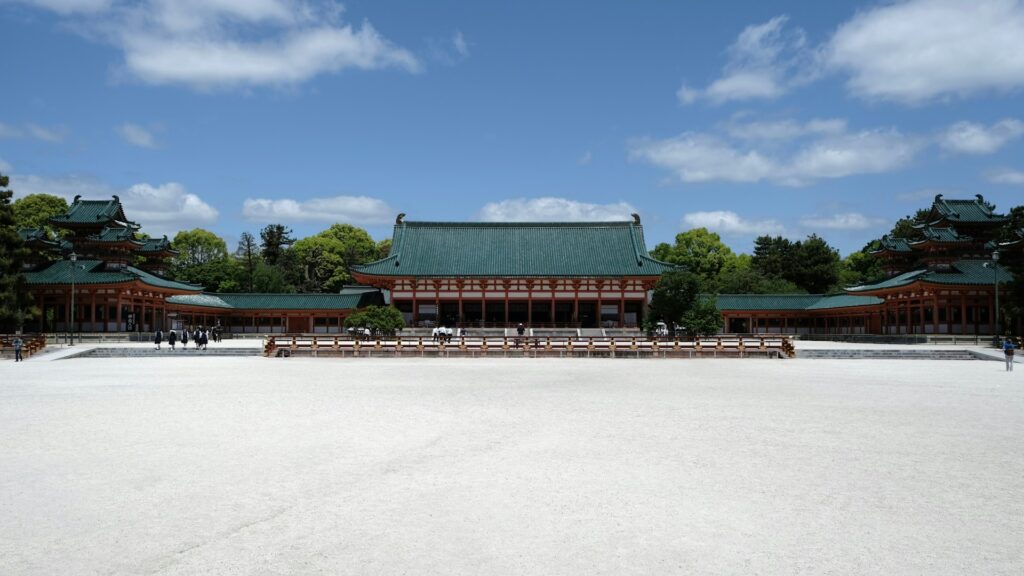
Heian Jingu was established in 1895, a significant year marking the 1,100th anniversary of the transfer of the capital to Heian-kyo (modern-day Kyoto). Kyoto had long flourished as Japan’s capital, but after the Meiji Restoration, it ceded that title to Tokyo. This transition prompted the people of Kyoto to reassess their culture and history, sparking a desire for revival.
Heian Jingu was built in response to this sentiment, enshrining Emperor Kanmu, a pivotal figure who ushered in the Heian period. The establishment of the Jingu served as a symbolic act to reaffirm Kyoto’s cultural identity, reflecting the community’s deep-rooted connection to its historical legacy.
Heian Jingu: A Monument to Kyoto’s History
Heian Jingu is a remarkable tribute to Kyoto’s rich history and cultural heritage. Dedicated to Emperor Kanmu, the founder of Heian-kyo, and Emperor Komei, it preserves the grandeur of the Heian period.
Emperor Kanmu played a pivotal role in establishing Kyoto as Japan’s cultural and political center. Additionally, the shrine’s architecture, inspired by the imperial palace of the Heian period, further enhances its historical and cultural significance.
Architectural Marvel: A Walk Through the Jingu
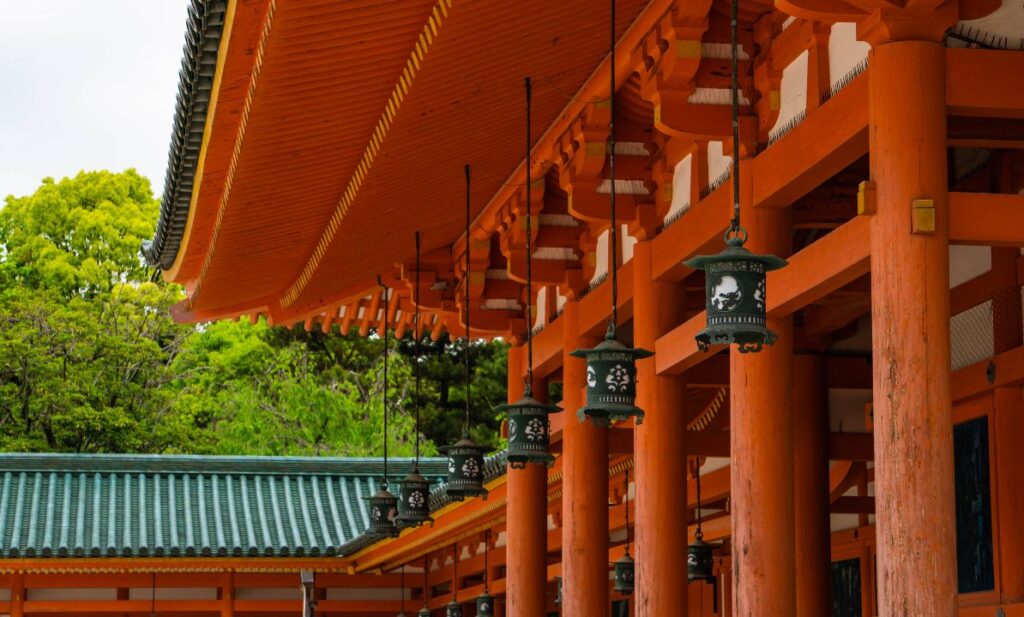
The Majestic Architecture of Heian Jingu
Heian Jingu, a prominent landmark in Kyoto, captivates visitors with its stunning architectural design. The most striking feature is its towering 24.4-meter-tall torii gate. Painted in a vibrant shade of vermilion, this grand entranceway makes a powerful statement.
Beyond the torii gate, a series of equally impressive vermilion-lacquered buildings awaits. Modeled after the imperial palace of the Heian period, structures like the Otenmon gate and the Daigokuden hall evoke the grandeur of ancient Kyoto.
The Daigokuden hall, in particular, is a faithful reconstruction of the inner palace of Heian-kyo, offering visitors a tangible connection to the past. These meticulously restored buildings from the Meiji era stand as powerful symbols of Kyoto’s rich cultural and historical heritage.
Heian Jingu: Where East Meets East
Heian Jingu was built in the Meiji period to commemorate the 1100th anniversary of the transfer of the capital to Heian-kyo (Kyoto). Its architectural design aims to recreate the culture of the Heian period while heavily incorporating elements of Chinese Tang-style architecture.
The vibrant vermilion-lacquered buildings, curved roofs, and the design of the Otenmon gate, among other features, showcase the influence of Tang architecture, creating a unique aesthetic that blends elegance and strength.
The curved roofs and column placements, in particular, are typical characteristics of Tang-style architecture, and the contrasting colors and intricate details further highlight these features.
Heian Jingu continues to captivate visitors as a testament to the historical exchange between Japanese and Chinese cultures.
A Garden Through the Seasons: Heian Jingu
Beyond the majestic architecture of Heian Jingu lies a serene and beautiful garden that further enhances its allure.
This expansive pond garden, designed around a central pond, is a must-see. Divided into four distinct areas – East Garden, West Garden, Central Garden, and South Garden – it offers a unique seasonal beauty in each.
From the vibrant cherry blossoms in spring to the breathtaking autumn foliage, the garden transforms with the changing seasons, evoking the landscapes admired by the nobles of the Heian period. Visitors can find solace and deepen their appreciation for history within this tranquil setting.
Seasonal Highlights: When to Visit

Spring:Cherry Blossom Magic at Heian Jingu
In spring, Heian Jingu blossoms into a breathtaking paradise of cherry blossoms, with approximately 300 trees painting the garden in a beautiful shade of pink.
The weeping cherry trees are a spectacle to behold, their vibrant hues and delicate fragrance creating an unforgettable sensory experience.
Walking through the tunnel of cherry blossoms feels like being enveloped in a cloud of petals, offering a magical and enchanting atmosphere.
At night, the cherry blossoms are illuminated, casting a mesmerizing glow that captivates visitors with their ethereal beauty.
Summer: A Lush Retreat
Heian Jingu transforms into a verdant oasis during the summer months.
The Shin-en Garden, renowned for its seasonal beauty, is particularly captivating in summer.
Dappled sunlight filters through the trees, creating a serene ambiance as a gentle breeze caresses visitors. The tranquil waters mirror the vibrant greenery, forming a picturesque tableau.
This peaceful sanctuary offers a respite for both mind and body. The surrounding area comes alive with various summer events, fostering a lively atmosphere. Heian Jingu stands as a testament to the harmonious coexistence of nature and culture, encapsulating the essence of Japan.
Autumn: A Foliage Lover’s Paradise
Heian Jingu is a renowned destination for autumn foliage.
The Shin-en Garden, a vibrant tapestry of autumn colors, showcases trees adorned in hues of crimson and gold. The tranquil pond mirrors the stunning foliage, creating a picturesque reflection.
A leisurely stroll through the garden, bathed in dappled sunlight and surrounded by the gentle rustle of leaves, offers a serene and captivating experience.
The peak season for viewing the foliage typically falls between mid and late November.
The harmonious blend of historical architecture and autumnal beauty provides a truly inspiring experience.
Explore the Japanese strolling garden and immerse yourself in the beauty of the autumn season.
Winter: Enchanting Snowscape:
Heian Jingu, cloaked in a blanket of pristine snow during winter, evokes a scene straight from a Japanese ink painting.
The striking contrast between the vermilion-lacquered buildings and the pristine white snow captivates visitors.
A serene atmosphere descends, punctuated by the gentle sound of snow falling on trees and stone lanterns, heralding the arrival of winter.
The tranquility of the early morning allows for moments of peaceful reflection. Simply breathing deeply while gazing at the snowy landscape is incredibly refreshing.
At night, enchanting illuminations transform the Jingu into a magical realm. The harmonious blend of nature and history creates an unforgettable experience.
Tips for First-Time Visitors
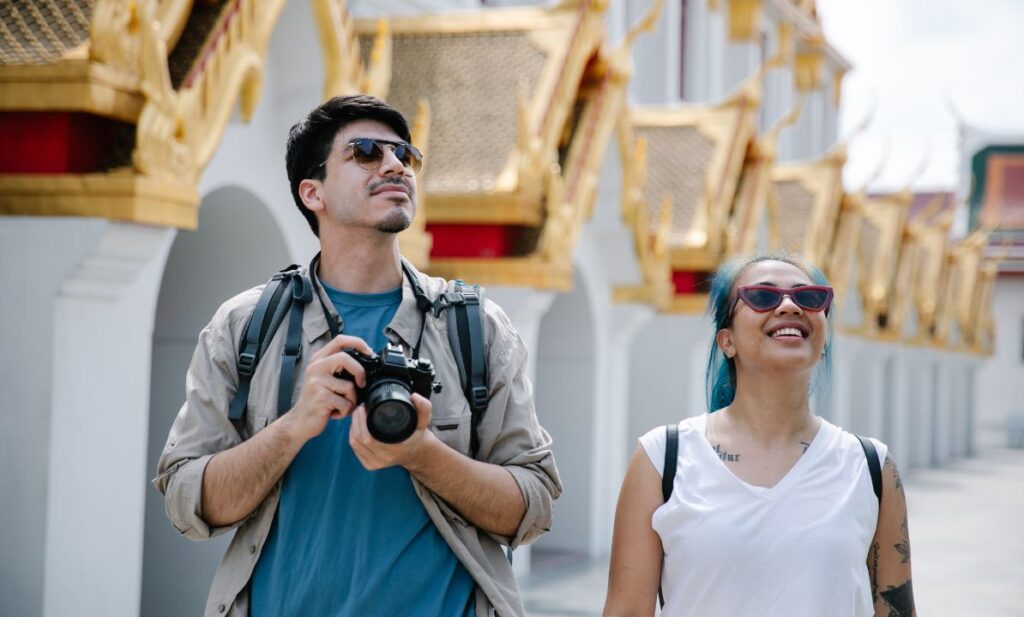
Getting There: Exploring Heian Jingu
Reaching Heian Jingu from Kyoto is a simple and enjoyable journey.
The most convenient option is to take City Bus Route 5 from JR Kyoto Station and alight at the “Okazaki Koen Bijutsukan・Heian Jingu-mae” stop.
From there, it’s a leisurely 5-minute stroll to the majestic Jingu gate.
Alternatively, you can take the Tozai Subway Line to Higashiyama Station and enjoy a pleasant 10-minute walk.
For a more comfortable journey, a taxi ride from JR Kyoto Station takes approximately 15 minutes.
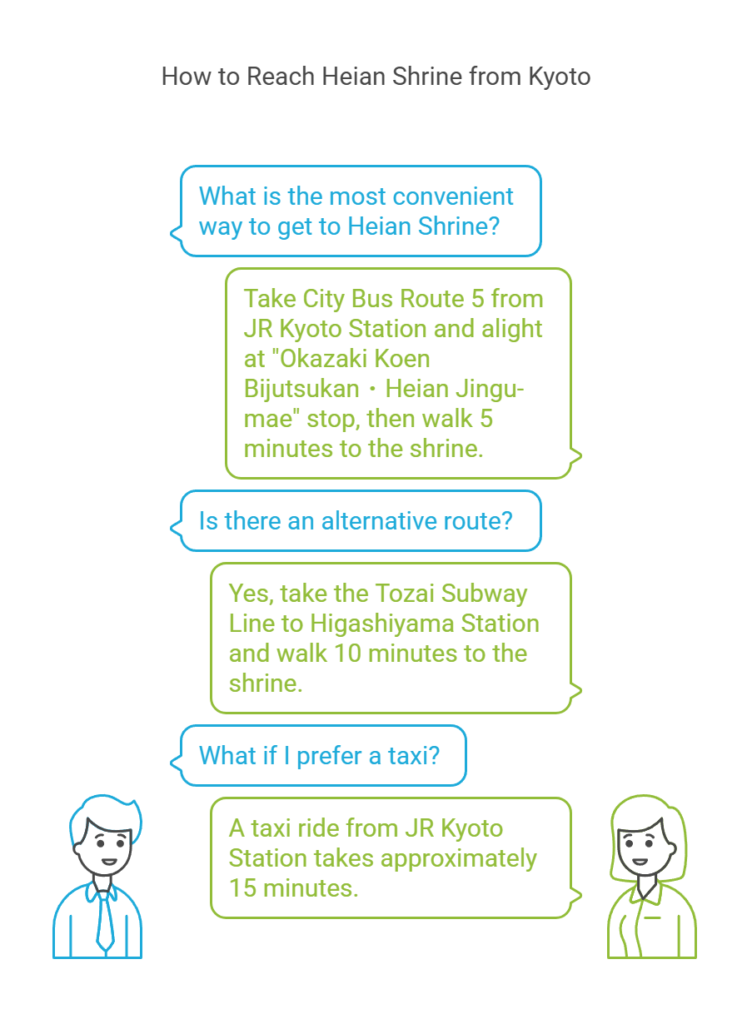
Visiting Hours & Fees
Visiting the main Jingu and its surrounding grounds at Heian Jingu is free of charge and open to the public at all times.
However, admission to the Shinden, or garden area, requires a fee of 600 yen for adults and 300 yen for children.
Visiting hours vary depending on the season. Typically, the Jingu is open from 6:00 AM to 5:00 PM, but visiting hours may be extended during peak tourist seasons such as spring and autumn.
The opening hours for the Shinden also vary by season.
For example, from March 15th to September 30th, the Shinden is open from 8:30 AM to 5:30 PM (last entry at 5:00 PM).
For the most up-to-date information, please visit the official Heian Jingu website.
It is especially recommended to check the website before your visit during peak seasons like cherry blossom and autumn foliage viewing
Beyond Heian Jingu: Discover the Charms of Okazaki
Okazaki, the area surrounding Heian Jingu, is a fantastic destination for experiencing the rich history and natural beauty of Kyoto.
The expansive Okazaki Park, renowned for its breathtaking cherry blossoms, is home to attractions such as the Kyoto National Museum and the Kyoto City Zoo, making it an ideal spot for families.
The park offers stunning views throughout the year. Nearby, you’ll discover historic gems like the Philosopher’s Path and Nanzen-ji Temple, providing a genuine taste of Kyoto’s cultural heritage.
For art enthusiasts, the Kyoto City Kyocera Museum showcases contemporary art exhibits.
After exploring Heian Jingu, indulge in the culinary delights of Kyoto by dining at one of the many restaurants serving local specialties.
Cultural Significance: Festivals and Events
Jidai Matsuri: A Journey Through Kyoto’s History
Held annually on October 22nd, the Jidai Matsuri at Heian Jingu is one of Kyoto’s most celebrated festivals, renowned for its rich historical traditions.
Initiated in 1895 to commemorate the 1,100th anniversary of the transfer of the capital to Heian-kyo, the festival features a magnificent procession that unfolds the history of Kyoto from the Heian period to the Meiji era.
Approximately 2,000 participants don period-specific attire and parade along a 4.5-kilometer route, commencing at the Kyoto Imperial Palace and culminating at Heian Jingu.
The procession unfolds in reverse chronological order, beginning with the vibrant atmosphere of the Meiji Restoration and culminating in the solemn grandeur of the Heian-kyo era’s founding. It is as if the pages of a history textbook have come to life.
The costumes of Heian-era nobles and samurai, in particular, vividly capture the elegance and sophistication of the time, captivating spectators.
The Jidai Matsuri serves as more than just a festival; it plays a crucial role in preserving and transmitting Kyoto’s rich historical and cultural heritage to future generations.
The meticulous attention to historical accuracy in the costumes, props, and participants’ performances has earned the festival acclaim as a “moving historical painting.”
As a quintessential autumn event in Kyoto, the Jidai Matsuri attracts a large number of domestic and international tourists, showcasing the enduring traditions and vibrant spirit of this ancient city.
Experiencing Heian Jingu Throughout the Year
Heian Jingu serves as a vibrant cultural hub in Kyoto, hosting a diverse array of traditional events throughout the year, most notably the grand Jidai Matsuri.
On February 3rd, the Setsubun Festival commences with ancient rituals to ward off evil spirits and usher in good fortune, marking the auspicious beginning of the new year.
In early summer, the serene Tanabata Wind Chime Festival fills the Jingu grounds with the gentle melodies of countless wind chimes, offering visitors a sense of tranquility and peace.
Autumn paints the Jingu in a magical hue, with illuminated structures and vibrant foliage creating a breathtaking spectacle.
Throughout the winter, various events, including Setsubun and New Year’s rituals, are held, fostering a strong sense of community and preserving cherished traditions.
The expansive gardens of Heian Jingu harmonize seamlessly with the changing seasons, offering visitors a profound experience of Japanese culture and the beauty of nature.
More than just a tourist destination, the majestic Jingu and its serene gardens serve as a place of tranquility and spiritual renewal for both locals and visitors alike, deeply rooted within the heart of the community.
Conclusion: A Must-See Icon of Kyoto
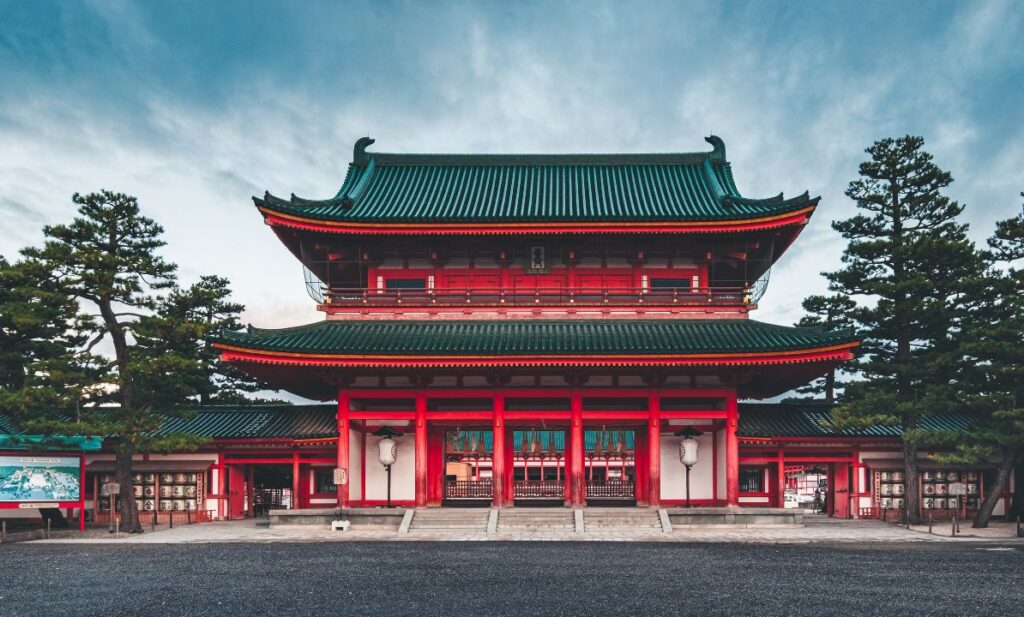
Heian Jingu blends history, culture, and natural beauty, making it a must-visit destination in Kyoto. Key highlights include:
Historical Roots: Built to honor Kyoto’s 1,100th anniversary and emperors Kanmu and Komei.
Striking Architecture: Features a towering vermilion torii gate and buildings inspired by the Heian period.
Seasonal Gardens: Shin-en Garden offers stunning scenery year-round, from cherry blossoms to snowy landscapes.
Vibrant Festivals: Don’t miss the Jidai Matsuri, a historic parade, or the serene Tanabata Wind Chime Festival.
Visitor Info: Easily accessible with free grounds access; garden entry is 600 yen.
Heian Jingu offers a serene escape and a deep connection to Japan’s cultural heritage, perfect for any traveler.
